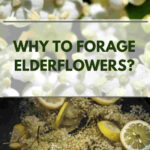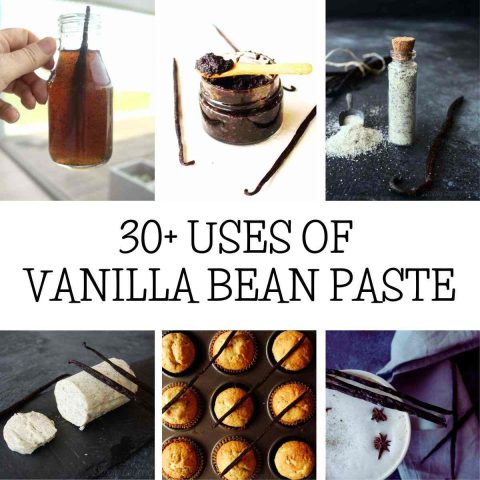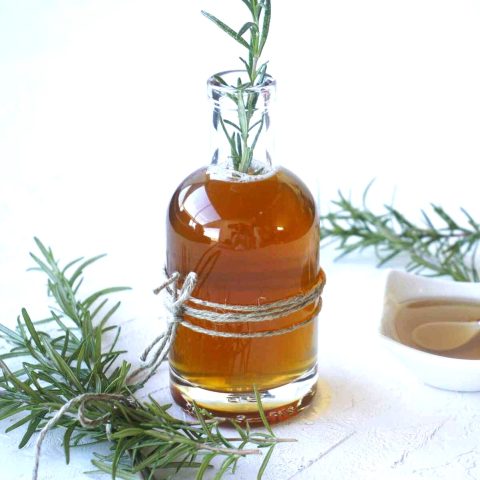Learn how to identify and harvest elderflowers, their benefits for our health, and how to use them in recipes, remedies, and homemade skincare products.
The place where I live is well known for its elderflower blossoms. They grow abundantly here, along rivers and railways, hedgerows, and their sweet scent fills the air when in season. The wonderful thing about elderflowers is that they come twice a year. The first bloom appears in spring, typically in late May, with clusters of intensely fragrant, yellowish-white flowers. Then, in autumn, the plants offer a second gift: rich tassels of dark berries that weigh down the slender branches, bending them toward the ground.

What is Elderflower?
Elderflower is the blossom of the elder plant—Sambucus nigra—the same plant that produces elderberries. While elderberries are the fruits that ripen in early fall, elderflowers bloom in late spring.
When elderflowers begin to bloom, they’re quite easy to identify. The plant produces large umbels of small cream-coloured flowers (4–12 inches or 10–30 cm in diameter). Each blossom has five rounded petals and five protruding stamens. Their creamy color and distinctive fragrance are typical of elderflowers, which bloom from late spring to early summer, depending on weather and location.

Elderflower leaves and stems
When an elder is not in bloom, its fresh leaves and stems can help with identification.
Elder has finely toothed, lance-shaped green leaves with lighter veins that fade and narrow toward the edges. Young plants, in their first year of growth, have green stems. As the plant matures, the stems develop bark. A typical elderberry plant often has both green stems and older, woody stems with bark.
The woody stems feature tiny bumps, known as lenticels, which become more pronounced as the plant ages. These markings make it easier to identify elderberry bushes, even outside the flowering season.
Where does Elderflower grow?
Elder shrubs can be found all over Europe, North America and other parts of the world mainly in the Northern Hemisphere. While european elder (Sambucus nigra) is native to Europe, its subsp. American black elder (Sambucus nigra canadensis) is native to eastern North America. People living in western North America can find more often blue elder (Sambucu nigra subsp. cerulea) as it naturally grow there.
Harvesting Elderflowers
When harvesting flowers, remember that you are reducing the fall elderberry crop with every blossom head you snip. So, harvest the flowers modestly, don’t take more than 20-30 % of the flowers from one plant. Keep some for bees! Look for fresh, fully opened flowers that haven’t turned brown yet. Pick them early morning on a sunny day. Inspect them carefully and remove all bugs and insects by hand. Don’t wash them as you will rinse away the pollen that is the main carrier of flavor and scent of elderflowers.

Preserving Elderflowers
You can use fresh elderflowers in cordial, ice cream, or use them to enhance jams. If you prefer to keep them for later use, the best way is to dry them.
Air drying
Use drying screen or paper, carefully spread them on the sunny place, keep turning them every day till dried completely. It takes a few days, depending on the weather.
Hanging them upside down
Hang bunches of elderflowers upside down in sunny places where fresh air flows for several days. The scent is marvelous!
Using dehydrator
Once dried, store them in a sterilized jar in a cold, dry place; they last up to one year.

Elderflower benefits
Elderflower benefits
In 400 BCE, Hippocrates referred to the elder tree as his “medicine chest.” Other healers, including Theophrastus, Dioscorides and Galen, regarded the elder as one of nature’s greatest healing plants.
The number one antiviral herb on the planet, elderberries are packed with antioxidants and flavonoids that successfully deactivate viruses in our bodies. Known for their high content of vitamin C and antioxidants mainly polyphenols (1)
Elderflowers help stimulate the immune system and increase the activity of antioxidant enzymes in the blood. In other words, Elderflowers can help overcome symptoms of flu and cold. They have been for centuries used to treatment of cough, flu, constipation and bronchitis (2)

Elderflower benefits for skin
These Sweet-scented petals with anti-inflammatory and antiviral properties also have also great benefits for the skin.
Anti-aging effect
Bioflavonoids and vitamins that are present in Elderflowers reduce fine lines and the appearance of wrinkles. These antioxidants also encourage the growth of new cells and make the skin appear younger.

Improving skin appearance
Elderflowers are mildly astringent and help minimize pores and dry up oily skin. Their ability to tighten the skin and make it look fresher and smoother rejuvenates its appearance.
Are elderflowers safe?
Raw elderberries and other parts of the elder plant can be poisonous. The leaves, stems, seeds, roots, and raw berries contain natural compounds called cyanogenic glycosides, which can be toxic when overeaten. Raw berries or other fresh parts of the plant can cause nausea, vomiting, stomach cramps, diarrhea, and weakness.
Elderflowers, buds and cooked elderberries are edible and safe in recipes and remedies.
Foraging or growing elderflowers?
Foraging is fun, especially if you live in a place where elderflowers grow abundantly. If you don’t have elderflowers growing wild, cultivating them in your garden is easy and rewarding.
“There should, of course, be an elder tree in every herb garden”
Eleanour Sinclair Rohde, A garden of Herbs, 1936
You can propagate new plants from an old shrub. That way, however, you might miss some information about its productivity or disease resistance. Alternatively, you may decide to purchase cuttings or live plants that will have your desired characteristics.
Another option might be to grow elder from seeds, which can be challenging, and most growers don’t recommend it.
Elderflowers recipes
Elderflower recipes don’t stop with elderflower syrup or cocktails
Fragrant elderflowers add subtle flowery, yet fruity notes to both food and drinks. Bakers often infuse their tiny white flowers to flavor wedding cakes, tarts, or even ice cream.
The most popular use, however, is in elderflower drinks and cocktails. Elderflower cordial or syrup pairs well with gin or tonic, or dilute it with sparkling water for a refreshing spritz. St. Germain, a liqueur made from elderflowers, adds a fragrant twist to classic recipes. For a sweet treat, try our elderflower fritters, crispy, golden, and always delightful.
The pleasant aroma and intensely floral flavor make elderflower perfect for making Elderflower popsicles, marshmallow fluff, yogurt, or elderflower rhubarb jam.

Elderflower also helps soothe inflamed nasal passages and is a popular natural remedy for colds and flu. Elderflower tea makes a delicious and comforting drink that helps ease coughs, runny noses, and sore throats. It’s also a natural source of vitamin C and antioxidants.

Elderflowers in remedies
I love to use Elderflower cordial to make these kid’s popular Elderberry gummies. When making them I use both Elderberries in syrup and Elderflowers in cordial that’s where their two colors come from.
These homemade cough syrup, vitamin syrup and elderflower cider I make every year. I stock my homemade apothecary with them when Elder flowers bloom and it last till the cold and flu season hits.
In skincare products
Elderflowers are known for their softening and anti-wrinkle properties. They are especially useful for older skin so I usually make this Elderflower salve for my mom or my mom in law, which make always a great gift. If you plan to do so start with elderflower oil that you need to make this salve.

What is elderflower flavor?
Elderflower has one of the most delightful natural aromas—sweet, floral, and unmistakably fresh. Its flavor is light and fragrant, with subtle notes of citrus, hints of vanilla, and a touch of tropical fruit, often compared to passionfruit.












I dried some elderberries from the bush at my in-laws’ house this some to use for making syrup, but I didn’t know all the things you could do with the flowers! Thanks for the great ideas! I’ll have to see about trying some when they’re blooming in the spring.
I’ve never used fresh elderflowers, only dried but they are MAGICAL! So great in a face toner or lotion.
So many amazing ideas for elderflowers. I make the cordial every year and kids love it for a refreshing summer drink.
I’m going to try the tea and salve now!
Thank you
I have been growing my elderflowers for 5 yrs now and my biggest disappointment is….although the plants flower prolifically, the flowers have no scent and they don’t set seeds. I have had to purchase to make the syrup and absolutely love it.
I’m hoping you can shed some light for me, otherwise, reluctantly I will remove them and start again. Many thanks.
Hi Mary, first check what kind of elderfloers do you have. The flowers of Sambucus nigra are very scented.
The seeds of elder are hidden in their berries. So you need to wait for elderflowers turn into elderberries to get their seeds.
If you are looking to propagate your elderberry plant, you can bury one of the lower branches and it will root. Or you can cut a low branch and try to get it to root.
Is the Elderflower syrup good for high blood pressure?
How it works?
Elderflower syrup is not typically used as a primary treatment for high blood pressure. However, it may offer some potential benefits that could indirectly help manage blood pressure:
Diuretic Properties: Elderflowers are known for their mild diuretic properties, which can promote increased urine production. This may help reduce excess fluid in the body and potentially lower blood pressure in individuals with fluid retention.
Antioxidants: Elderflowers contain antioxidants, which can help combat oxidative stress and inflammation. Chronic inflammation can contribute to high blood pressure, so reducing inflammation through antioxidant-rich foods and herbs may be beneficial.
Relaxation: Some people find elderflower preparations to have a calming effect. Reduced stress and anxiety can positively influence blood pressure levels.However, it’s important to note that elderflower syrup should not be used as a sole or primary treatment for high blood pressure. If you have high blood pressure, it’s essential to consult with a healthcare professional.
My coworker gifted me fresh elderflowers cut from his tree. We’re located in NorCal, USA. The flowers look like the ones I know from my native country Sweden, but while those flowers had the distinct elderflower scent, the Californian does not. I did make cordial out of it, but it just tastes like lemon. I suppose the Swedish type is Sambucus Nigra, and the American is another type?
HI Mia, you’re correct — in Sweden you had Sambucus nigra with its strong floral aroma. In Northern California, your coworker’s tree is almost certainly Sambucus canadensis (American elder) or a related variety, which has little to no fragrance in the flowers. That’s why your cordial just tasted like lemon.